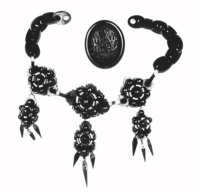Jet & jet jewellery
Jet is a black mineral. It was formed from the wood of a type of ‘monkey puzzle’ tree over 135 million years ago. It is very light and can be very highly polished. It is highly prized for making jewellery and ornaments and is found throughout the North York Moors. Whitby is famous for the manufacture of jet jewellery, particularly so in the last part of the 19th century when Queen Victoria popularised this type of jewellery. Whitby Museum has one of the best collections of jet artifacts in the world with over 500 very varied examples which include jewellery (brooches, pendants), chess tables, busts, models of Whitby Abbey and bible covers. This pre-eminent collection, along with jet makers tools, a 110 year old mechanical model of a jet workshop, indentures and design books, and Clothes is important for three reasons :
- industrial history – at its height in the 19th century the industry was a major employer in the region with over 200 miners and 1500 other workers in Whitby in 1873
- social history – jet exemplifies the Victorian attitude towards death and mourning displayed by Queen Victoria herself as well as the social background to the industry
- fine art – many of the objects are of great intricacy and beauty

Chessboard designed and made by John Sherwood.
Some of the finest work manifests itself in the two jet chess tables. Three jet chess boards are known to have been made in Whitby. The Museum owns two (the third has been lost sight of) including that designed and carved by John Sherwood which was begun in 1895 being intended for the Diamond Jubilee of Queen Victoria, but which took four years to complete. It was described at the time as ‘the crowning triumph of the jet age – the most beautiful object of its kind ever made’. This particular board was acquired in 1996 from Mr Robert Murfield in memory of his late wife Martha Cox whose father William Cox was one of the last Whitby jet carvers.

Jet Workshop Model made by George Wood
One of the most interesting artifacts is the replica of the jet workshop model made by George Wood, a jet worker, in 1889. This model stood for many years in the doorway of Elisha Walker’s jet shop at 97 Church Street in Whitby. The heads of the 6 jet workers were carved from the bowls of clay pipes and were caricatures of George Wood’s fellow jet workers. It was driven by clockwork and the men treadle their machines such as polishers, turners, finishers, grinders, working the jet, whilst the foreman’s head turns periodically to see that everyone is working hard! The model was donated to our Museum and was on display for many years but it became too frail and fragile to be left on display. So we commissioned a replica which was made by Alan Dickinson and Gary Thwaites and was generously funded by the Thomas William Varley Roe deceased fund. This replica is a very popular object in the Museum. The original model is kept in store at the Museum.
 |
 |
 |
| Jet necklace | Jet Model of Whitby Abbey before the tower fell carved by Joseph Lyth | Jet prayer book cover |
For further information see our Frequently Asked Questions about Jet
